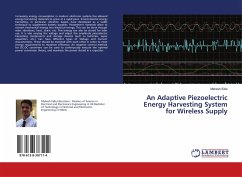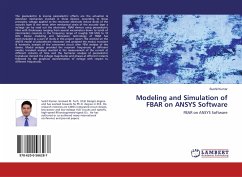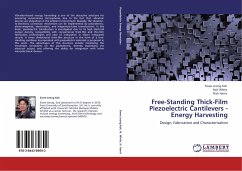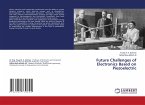- Gebundenes Buch
- Merkliste
- Auf die Merkliste
- Bewerten Bewerten
- Teilen
- Produkt teilen
- Produkterinnerung
- Produkterinnerung
Authoritative reference making piezoelectric materials technology more accessible by crossing the boundary between fundamental materials physics and applied engineering Piezoelectric Materials provides a comprehensive overview of the subject, an important class of smart materials which are useful as both actuators and sensors, covering materials, properties, and devices, including case studies of example applications. In addition to providing the underlying science on the subject, the text also supports those interested in using piezoelectric actuators and sensors in real world applications.…mehr
Andere Kunden interessierten sich auch für
![A Novel Fluid-Flow Based Micro Energy Harvester for Bio-medical device A Novel Fluid-Flow Based Micro Energy Harvester for Bio-medical device]() Mohammad BhuyanA Novel Fluid-Flow Based Micro Energy Harvester for Bio-medical device27,99 €
Mohammad BhuyanA Novel Fluid-Flow Based Micro Energy Harvester for Bio-medical device27,99 €![Advanced Piezoelectric Materials Advanced Piezoelectric Materials]() Advanced Piezoelectric Materials214,99 €
Advanced Piezoelectric Materials214,99 €![An Adaptive Piezoelectric Energy Harvesting System for Wireless Supply An Adaptive Piezoelectric Energy Harvesting System for Wireless Supply]() Mahesh EdlaAn Adaptive Piezoelectric Energy Harvesting System for Wireless Supply24,99 €
Mahesh EdlaAn Adaptive Piezoelectric Energy Harvesting System for Wireless Supply24,99 €![Modeling and Simulation of FBAR on ANSYS Software Modeling and Simulation of FBAR on ANSYS Software]() Sushil KumarModeling and Simulation of FBAR on ANSYS Software27,99 €
Sushil KumarModeling and Simulation of FBAR on ANSYS Software27,99 €![Free-Standing Thick-Film Piezoelectric Cantilevers -Energy Harvesting Free-Standing Thick-Film Piezoelectric Cantilevers -Energy Harvesting]() Swee-Leong KokFree-Standing Thick-Film Piezoelectric Cantilevers -Energy Harvesting52,99 €
Swee-Leong KokFree-Standing Thick-Film Piezoelectric Cantilevers -Energy Harvesting52,99 €![Ambient Energy Harvesting Using Piezoelectric Materials Ambient Energy Harvesting Using Piezoelectric Materials]() Ritendra MishraAmbient Energy Harvesting Using Piezoelectric Materials37,99 €
Ritendra MishraAmbient Energy Harvesting Using Piezoelectric Materials37,99 €![Future Challenges of Electronics Based on Piezoelectric Future Challenges of Electronics Based on Piezoelectric]() Fouad A. S. SolimanFuture Challenges of Electronics Based on Piezoelectric40,99 €
Fouad A. S. SolimanFuture Challenges of Electronics Based on Piezoelectric40,99 €-
-
-
Authoritative reference making piezoelectric materials technology more accessible by crossing the boundary between fundamental materials physics and applied engineering Piezoelectric Materials provides a comprehensive overview of the subject, an important class of smart materials which are useful as both actuators and sensors, covering materials, properties, and devices, including case studies of example applications. In addition to providing the underlying science on the subject, the text also supports those interested in using piezoelectric actuators and sensors in real world applications. Early chapters help the reader understand the limits and appropriate operating conditions for the piezoelectric and ferroelectric devices described in later chapters. Other topics discussed in Piezoelectric Materials include: The range of piezoelectric and ferroelectric materials and their fundamental properties and applications in sensors, actuators, and as energy harvesting elements. Designs for various piezoelectric devices, including case studies on piezoelectric actuator applications, e.g., for servovalves, hydrophones, and active vibration control. Key limits of these materials and fundamental equations to predict displacement, force, resonance, and power requirements. Piezoelectric Materials serves as an invaluable reference on the subject and makes piezoceramic materials technology more accessible to researchers, advanced students, and practicing engineers. The text is also helpful to those in industries using piezoelectrics, in particular manufacturers of optics, photonics, and nanometrology equipment.
Produktdetails
- Produktdetails
- Verlag: John Wiley & Sons Inc
- Seitenzahl: 256
- Erscheinungstermin: 18. Dezember 2025
- Englisch
- ISBN-13: 9781118572887
- ISBN-10: 1118572882
- Artikelnr.: 60904230
- Herstellerkennzeichnung
- Libri GmbH
- Europaallee 1
- 36244 Bad Hersfeld
- gpsr@libri.de
- Verlag: John Wiley & Sons Inc
- Seitenzahl: 256
- Erscheinungstermin: 18. Dezember 2025
- Englisch
- ISBN-13: 9781118572887
- ISBN-10: 1118572882
- Artikelnr.: 60904230
- Herstellerkennzeichnung
- Libri GmbH
- Europaallee 1
- 36244 Bad Hersfeld
- gpsr@libri.de
Christopher R. Bowen University of Bath, UK Andrew R. Plummer University of Bath, UK Series Editors Arthur Willoughby University of Southampton, Southampton, UK Peter Capper formerly of SELEX Galileo Infrared Ltd, Southampton, UK Safa Kasap University of Saskatchewan, Saskatoon, Canada
Preface xi
Acknowledgements xiii
1 Introduction 1
1.1 Active and Sensory Materials for Smart Systems 1
1.2 Energy Harvesting Materials 3
1.3 Multifunctional Materials, Devices, Systems and Structures 3
1.4 Piezoelectric, Pyroelectric and Ferroelectric Materials 4
References 5
2 Piezoelectric Fundamentals 7
2.1 Piezoelectric Materials 7
2.2 Ferroelectric Materials 10
2.2.1 Non-centrosymmetric Unit Cells 10
2.2.2 Lead Zirconate Titanate (Pb(ZrXTi1¿x)O3 , Pzt) Ferroelectrics 13
2.2.3 Ferroelectric Domains 14
2.2.4 Poling of Ferroelectric Materials 16
2.3 Pyroelectric Materials 18
2.4 Piezoelectric Forms: Bulk, Thin Films and Fibre Composites 19
2.4.1 Piezoelectric Composites and Connectivity 19
2.4.2 Active Fibre Composites and Macro-Fibre Composites 20
2.5 Concluding Remarks 22
References 23
3 Properties of Piezoelectric Materials 27
3.1 Introduction 27
3.2 Constitutive Equations 28
3.2.1 Alternative Single-Axis Formulations 28
3.2.2 Multi-Axis Linear Model 30
3.2.2.1 Example Piezoelectric Element 32
3.2.3 Coupling Coefficients 34
3.3 Polarisation-Electric Field Response of a Ferroelectric 36
3.4 Strain-Field Response of a Ferroelectric 39
3.5 Material Properties and Selection of Materials 41
3.5.1 Barium Titanate (BaTiO3) 41
3.5.2 Lead Zirconate Titanate (PZT, Pb(Zr,Ti)O3) 42
3.5.3 Ferroelectric Polymers 48
3.6 Mechanical Depolarisation of Ferroelectric Materials 48
3.7 Creep of Ferroelectric Materials 52
3.8 Strain Limits of Piezoelectric Actuators (Expansion) 54
3.9 Strain Limits of Piezoelectric Actuators (Contraction) 55
3.10 Resonance Behaviour of Piezoelectric Materials and Ceramic Structures
55
3.11 Ageing of Ferroelectrics 57
3.12 Temperature Limits and Self-Heating 58
3.13 Cyclic Operation - Frequency Effects 58
3.13.1 Self-Heating Due to Ferroelectric Hysteresis 59
3.13.2 Current Requirements During Frequency Cycling 60
3.14 Thermal Expansion Coefficient 61
3.15 Summary 62
References 62
4 Piezoelectric Actuators 65
4.1 Introduction 65
4.2 Free Displacement and Blocking Force 65
4.3 Single-Layer Actuator 67
4.4 Stack Actuators 71
4.4.1 Actuator Preloading 72
4.4.2 Piezoelectric Stack Actuator Selection Example 73
4.4.3 Optimum Stack Dimensions 76
4.4.4 Piezoelectric Actuator Stack Sizing Guidelines 77
4.5 Rectangular Bending Actuators (Bimorphs) 79
4.5.1 Bimorph Characteristics 79
4.5.2 Other Rectangular Benders 83
4.6 Ring Benders 84
4.6.1 Ring Bender Deformation Analysis 84
4.6.2 Ring Bender Free Displacement and Blocking Force 92
4.6.3 Other Circular Benders 95
4.7 Mechanical Amplification 95
4.8 Complex Actuator Design 97
4.8.1 Motion Accumulation 97
4.8.2 Ultrasonic Motors 98
4.9 Concluding Remarks 99
References 100
5 Sensors 101
5.1 Introduction 101
5.2 Piezoelectric Accelerometers 101
5.2.1 Accelerometer Modes of Operation (Compressive, Shear and Flexural d
33 and d15) 105
5.2.2 Material Selection for Accelerometers 106
5.3 Force and Pressure Sensors 110
5.3.1 High-Frequency Capability 111
5.3.2 Sensor Sensitivity 111
5.4 Temperature and Thermal Effects 113
5.5 Hydrophones 115
5.5.1 Background to Hydrostatic Coefficients 115
5.5.2 Derivation of Performance Indicators for Hydrophone Materials 116
5.5.3 Hydrophone Construction 120
5.6 Piezocomposite Sensors 123
5.6.1 Production of Piezoelectric Composites 127
5.7 Conclusions 130
References 130
6 Energy Harvesting 133
6.1 Introduction 133
6.2 Concept of Piezoelectric-Based Energy Harvesting 134
6.3 Piezoelectric Properties and Performance Figures of Merit (FoMs) 141
6.3.1 Derivation of Harvesting Figures of Merit (FoMs) 142
6.3.2 Mechanical Energy Input 142
6.3.3 Converting the Mechanical (Input) into Electrical Energy (Stored) 145
6.3.4 Producing an Output from the Stored Electrical Energy 147
6.4 Case Study: Piezoelectric Hydraulic Ripple Energy Harvesting 151
6.5 Pyroelectric Materials and Thermal Energy Harvesting 157
6.5.1 Performance Figures of Merit for Pyroelectric Harvesting and Sensing
159
6.6 Summary 163
References 163
7 Drive Electronics and Control 167
7.1 Introduction 167
7.2 Op-Amp Circuits 167
7.3 Voltage Amplifiers for Driving Actuators 169
7.4 Charge Amplifiers for Driving Actuators 171
7.5 Regenerative Amplifiers 174
7.6 Position Sensors for Feedback Control 176
7.6.1 Linear Variable Differential Transformer (LVDT) 176
7.6.2 Eddy Current Sensor 177
7.6.3 Capacitive Sensor 178
7.6.4 Laser Triangulation Sensor 178
7.6.5 Strain Gauge Sensor 178
7.7 Closed-Loop Controllers: Case Study 180
7.8 Signal Conditioning for Piezoelectric Sensors 182
7.8.1 Op-Amp Filtering Circuits 182
7.8.2 Signal Conditioning in Detail 186
7.9 Concluding Remarks 188
References 188
8 Case Studies 191
8.1 Introduction 191
8.2 Piezoelectric Valve Actuation 191
8.2.1 Internal Combustion Engine Fuel Injectors 191
8.2.2 Hydraulic Servo Valves 191
8.3 Piezoelectric Pumps 197
8.3.1 Introduction 197
8.3.2 Piezo Pump Example 198
8.4 Vibration Control of Flexible Structures 201
8.4.1 Smart Structure 201
8.4.2 Dynamic Modelling 203
8.4.3 Derivative Feedback Control 203
8.5 A Case Study of Actuator Self-Heating 205
8.5.1 Model for Temperature Increase Due to Hysteresis 205
8.5.2 Testing Actuator Self-Heating 207
8.5.3 Comparing Actuator Test Data with Expected Behaviour from Model 209
8.6 Piezoelectric Actuation of Bistable Morphing Structures 211
8.6.1 Composite Structure Manufacture 213
8.6.2 Actuator Materials and Attachment 214
8.6.3 Change in Laminate Shape in Response to Piezoelectric Actuation 214
8.7 Force Sensors, Shear Sensors and Hydrophones 217
8.7.1 Freeze Casting to Produce Porous Ceramics 217
8.7.2 Fabrication of Strain Sensor (d31 -Mode) 222
8.7.3 d 33 -Mode and d 15 -Mode Piezocomposite Sensors 223
8.8 Concluding Remarks 225
References 225
Index 229
Acknowledgements xiii
1 Introduction 1
1.1 Active and Sensory Materials for Smart Systems 1
1.2 Energy Harvesting Materials 3
1.3 Multifunctional Materials, Devices, Systems and Structures 3
1.4 Piezoelectric, Pyroelectric and Ferroelectric Materials 4
References 5
2 Piezoelectric Fundamentals 7
2.1 Piezoelectric Materials 7
2.2 Ferroelectric Materials 10
2.2.1 Non-centrosymmetric Unit Cells 10
2.2.2 Lead Zirconate Titanate (Pb(ZrXTi1¿x)O3 , Pzt) Ferroelectrics 13
2.2.3 Ferroelectric Domains 14
2.2.4 Poling of Ferroelectric Materials 16
2.3 Pyroelectric Materials 18
2.4 Piezoelectric Forms: Bulk, Thin Films and Fibre Composites 19
2.4.1 Piezoelectric Composites and Connectivity 19
2.4.2 Active Fibre Composites and Macro-Fibre Composites 20
2.5 Concluding Remarks 22
References 23
3 Properties of Piezoelectric Materials 27
3.1 Introduction 27
3.2 Constitutive Equations 28
3.2.1 Alternative Single-Axis Formulations 28
3.2.2 Multi-Axis Linear Model 30
3.2.2.1 Example Piezoelectric Element 32
3.2.3 Coupling Coefficients 34
3.3 Polarisation-Electric Field Response of a Ferroelectric 36
3.4 Strain-Field Response of a Ferroelectric 39
3.5 Material Properties and Selection of Materials 41
3.5.1 Barium Titanate (BaTiO3) 41
3.5.2 Lead Zirconate Titanate (PZT, Pb(Zr,Ti)O3) 42
3.5.3 Ferroelectric Polymers 48
3.6 Mechanical Depolarisation of Ferroelectric Materials 48
3.7 Creep of Ferroelectric Materials 52
3.8 Strain Limits of Piezoelectric Actuators (Expansion) 54
3.9 Strain Limits of Piezoelectric Actuators (Contraction) 55
3.10 Resonance Behaviour of Piezoelectric Materials and Ceramic Structures
55
3.11 Ageing of Ferroelectrics 57
3.12 Temperature Limits and Self-Heating 58
3.13 Cyclic Operation - Frequency Effects 58
3.13.1 Self-Heating Due to Ferroelectric Hysteresis 59
3.13.2 Current Requirements During Frequency Cycling 60
3.14 Thermal Expansion Coefficient 61
3.15 Summary 62
References 62
4 Piezoelectric Actuators 65
4.1 Introduction 65
4.2 Free Displacement and Blocking Force 65
4.3 Single-Layer Actuator 67
4.4 Stack Actuators 71
4.4.1 Actuator Preloading 72
4.4.2 Piezoelectric Stack Actuator Selection Example 73
4.4.3 Optimum Stack Dimensions 76
4.4.4 Piezoelectric Actuator Stack Sizing Guidelines 77
4.5 Rectangular Bending Actuators (Bimorphs) 79
4.5.1 Bimorph Characteristics 79
4.5.2 Other Rectangular Benders 83
4.6 Ring Benders 84
4.6.1 Ring Bender Deformation Analysis 84
4.6.2 Ring Bender Free Displacement and Blocking Force 92
4.6.3 Other Circular Benders 95
4.7 Mechanical Amplification 95
4.8 Complex Actuator Design 97
4.8.1 Motion Accumulation 97
4.8.2 Ultrasonic Motors 98
4.9 Concluding Remarks 99
References 100
5 Sensors 101
5.1 Introduction 101
5.2 Piezoelectric Accelerometers 101
5.2.1 Accelerometer Modes of Operation (Compressive, Shear and Flexural d
33 and d15) 105
5.2.2 Material Selection for Accelerometers 106
5.3 Force and Pressure Sensors 110
5.3.1 High-Frequency Capability 111
5.3.2 Sensor Sensitivity 111
5.4 Temperature and Thermal Effects 113
5.5 Hydrophones 115
5.5.1 Background to Hydrostatic Coefficients 115
5.5.2 Derivation of Performance Indicators for Hydrophone Materials 116
5.5.3 Hydrophone Construction 120
5.6 Piezocomposite Sensors 123
5.6.1 Production of Piezoelectric Composites 127
5.7 Conclusions 130
References 130
6 Energy Harvesting 133
6.1 Introduction 133
6.2 Concept of Piezoelectric-Based Energy Harvesting 134
6.3 Piezoelectric Properties and Performance Figures of Merit (FoMs) 141
6.3.1 Derivation of Harvesting Figures of Merit (FoMs) 142
6.3.2 Mechanical Energy Input 142
6.3.3 Converting the Mechanical (Input) into Electrical Energy (Stored) 145
6.3.4 Producing an Output from the Stored Electrical Energy 147
6.4 Case Study: Piezoelectric Hydraulic Ripple Energy Harvesting 151
6.5 Pyroelectric Materials and Thermal Energy Harvesting 157
6.5.1 Performance Figures of Merit for Pyroelectric Harvesting and Sensing
159
6.6 Summary 163
References 163
7 Drive Electronics and Control 167
7.1 Introduction 167
7.2 Op-Amp Circuits 167
7.3 Voltage Amplifiers for Driving Actuators 169
7.4 Charge Amplifiers for Driving Actuators 171
7.5 Regenerative Amplifiers 174
7.6 Position Sensors for Feedback Control 176
7.6.1 Linear Variable Differential Transformer (LVDT) 176
7.6.2 Eddy Current Sensor 177
7.6.3 Capacitive Sensor 178
7.6.4 Laser Triangulation Sensor 178
7.6.5 Strain Gauge Sensor 178
7.7 Closed-Loop Controllers: Case Study 180
7.8 Signal Conditioning for Piezoelectric Sensors 182
7.8.1 Op-Amp Filtering Circuits 182
7.8.2 Signal Conditioning in Detail 186
7.9 Concluding Remarks 188
References 188
8 Case Studies 191
8.1 Introduction 191
8.2 Piezoelectric Valve Actuation 191
8.2.1 Internal Combustion Engine Fuel Injectors 191
8.2.2 Hydraulic Servo Valves 191
8.3 Piezoelectric Pumps 197
8.3.1 Introduction 197
8.3.2 Piezo Pump Example 198
8.4 Vibration Control of Flexible Structures 201
8.4.1 Smart Structure 201
8.4.2 Dynamic Modelling 203
8.4.3 Derivative Feedback Control 203
8.5 A Case Study of Actuator Self-Heating 205
8.5.1 Model for Temperature Increase Due to Hysteresis 205
8.5.2 Testing Actuator Self-Heating 207
8.5.3 Comparing Actuator Test Data with Expected Behaviour from Model 209
8.6 Piezoelectric Actuation of Bistable Morphing Structures 211
8.6.1 Composite Structure Manufacture 213
8.6.2 Actuator Materials and Attachment 214
8.6.3 Change in Laminate Shape in Response to Piezoelectric Actuation 214
8.7 Force Sensors, Shear Sensors and Hydrophones 217
8.7.1 Freeze Casting to Produce Porous Ceramics 217
8.7.2 Fabrication of Strain Sensor (d31 -Mode) 222
8.7.3 d 33 -Mode and d 15 -Mode Piezocomposite Sensors 223
8.8 Concluding Remarks 225
References 225
Index 229
Preface xi
Acknowledgements xiii
1 Introduction 1
1.1 Active and Sensory Materials for Smart Systems 1
1.2 Energy Harvesting Materials 3
1.3 Multifunctional Materials, Devices, Systems and Structures 3
1.4 Piezoelectric, Pyroelectric and Ferroelectric Materials 4
References 5
2 Piezoelectric Fundamentals 7
2.1 Piezoelectric Materials 7
2.2 Ferroelectric Materials 10
2.2.1 Non-centrosymmetric Unit Cells 10
2.2.2 Lead Zirconate Titanate (Pb(ZrXTi1¿x)O3 , Pzt) Ferroelectrics 13
2.2.3 Ferroelectric Domains 14
2.2.4 Poling of Ferroelectric Materials 16
2.3 Pyroelectric Materials 18
2.4 Piezoelectric Forms: Bulk, Thin Films and Fibre Composites 19
2.4.1 Piezoelectric Composites and Connectivity 19
2.4.2 Active Fibre Composites and Macro-Fibre Composites 20
2.5 Concluding Remarks 22
References 23
3 Properties of Piezoelectric Materials 27
3.1 Introduction 27
3.2 Constitutive Equations 28
3.2.1 Alternative Single-Axis Formulations 28
3.2.2 Multi-Axis Linear Model 30
3.2.2.1 Example Piezoelectric Element 32
3.2.3 Coupling Coefficients 34
3.3 Polarisation-Electric Field Response of a Ferroelectric 36
3.4 Strain-Field Response of a Ferroelectric 39
3.5 Material Properties and Selection of Materials 41
3.5.1 Barium Titanate (BaTiO3) 41
3.5.2 Lead Zirconate Titanate (PZT, Pb(Zr,Ti)O3) 42
3.5.3 Ferroelectric Polymers 48
3.6 Mechanical Depolarisation of Ferroelectric Materials 48
3.7 Creep of Ferroelectric Materials 52
3.8 Strain Limits of Piezoelectric Actuators (Expansion) 54
3.9 Strain Limits of Piezoelectric Actuators (Contraction) 55
3.10 Resonance Behaviour of Piezoelectric Materials and Ceramic Structures
55
3.11 Ageing of Ferroelectrics 57
3.12 Temperature Limits and Self-Heating 58
3.13 Cyclic Operation - Frequency Effects 58
3.13.1 Self-Heating Due to Ferroelectric Hysteresis 59
3.13.2 Current Requirements During Frequency Cycling 60
3.14 Thermal Expansion Coefficient 61
3.15 Summary 62
References 62
4 Piezoelectric Actuators 65
4.1 Introduction 65
4.2 Free Displacement and Blocking Force 65
4.3 Single-Layer Actuator 67
4.4 Stack Actuators 71
4.4.1 Actuator Preloading 72
4.4.2 Piezoelectric Stack Actuator Selection Example 73
4.4.3 Optimum Stack Dimensions 76
4.4.4 Piezoelectric Actuator Stack Sizing Guidelines 77
4.5 Rectangular Bending Actuators (Bimorphs) 79
4.5.1 Bimorph Characteristics 79
4.5.2 Other Rectangular Benders 83
4.6 Ring Benders 84
4.6.1 Ring Bender Deformation Analysis 84
4.6.2 Ring Bender Free Displacement and Blocking Force 92
4.6.3 Other Circular Benders 95
4.7 Mechanical Amplification 95
4.8 Complex Actuator Design 97
4.8.1 Motion Accumulation 97
4.8.2 Ultrasonic Motors 98
4.9 Concluding Remarks 99
References 100
5 Sensors 101
5.1 Introduction 101
5.2 Piezoelectric Accelerometers 101
5.2.1 Accelerometer Modes of Operation (Compressive, Shear and Flexural d
33 and d15) 105
5.2.2 Material Selection for Accelerometers 106
5.3 Force and Pressure Sensors 110
5.3.1 High-Frequency Capability 111
5.3.2 Sensor Sensitivity 111
5.4 Temperature and Thermal Effects 113
5.5 Hydrophones 115
5.5.1 Background to Hydrostatic Coefficients 115
5.5.2 Derivation of Performance Indicators for Hydrophone Materials 116
5.5.3 Hydrophone Construction 120
5.6 Piezocomposite Sensors 123
5.6.1 Production of Piezoelectric Composites 127
5.7 Conclusions 130
References 130
6 Energy Harvesting 133
6.1 Introduction 133
6.2 Concept of Piezoelectric-Based Energy Harvesting 134
6.3 Piezoelectric Properties and Performance Figures of Merit (FoMs) 141
6.3.1 Derivation of Harvesting Figures of Merit (FoMs) 142
6.3.2 Mechanical Energy Input 142
6.3.3 Converting the Mechanical (Input) into Electrical Energy (Stored) 145
6.3.4 Producing an Output from the Stored Electrical Energy 147
6.4 Case Study: Piezoelectric Hydraulic Ripple Energy Harvesting 151
6.5 Pyroelectric Materials and Thermal Energy Harvesting 157
6.5.1 Performance Figures of Merit for Pyroelectric Harvesting and Sensing
159
6.6 Summary 163
References 163
7 Drive Electronics and Control 167
7.1 Introduction 167
7.2 Op-Amp Circuits 167
7.3 Voltage Amplifiers for Driving Actuators 169
7.4 Charge Amplifiers for Driving Actuators 171
7.5 Regenerative Amplifiers 174
7.6 Position Sensors for Feedback Control 176
7.6.1 Linear Variable Differential Transformer (LVDT) 176
7.6.2 Eddy Current Sensor 177
7.6.3 Capacitive Sensor 178
7.6.4 Laser Triangulation Sensor 178
7.6.5 Strain Gauge Sensor 178
7.7 Closed-Loop Controllers: Case Study 180
7.8 Signal Conditioning for Piezoelectric Sensors 182
7.8.1 Op-Amp Filtering Circuits 182
7.8.2 Signal Conditioning in Detail 186
7.9 Concluding Remarks 188
References 188
8 Case Studies 191
8.1 Introduction 191
8.2 Piezoelectric Valve Actuation 191
8.2.1 Internal Combustion Engine Fuel Injectors 191
8.2.2 Hydraulic Servo Valves 191
8.3 Piezoelectric Pumps 197
8.3.1 Introduction 197
8.3.2 Piezo Pump Example 198
8.4 Vibration Control of Flexible Structures 201
8.4.1 Smart Structure 201
8.4.2 Dynamic Modelling 203
8.4.3 Derivative Feedback Control 203
8.5 A Case Study of Actuator Self-Heating 205
8.5.1 Model for Temperature Increase Due to Hysteresis 205
8.5.2 Testing Actuator Self-Heating 207
8.5.3 Comparing Actuator Test Data with Expected Behaviour from Model 209
8.6 Piezoelectric Actuation of Bistable Morphing Structures 211
8.6.1 Composite Structure Manufacture 213
8.6.2 Actuator Materials and Attachment 214
8.6.3 Change in Laminate Shape in Response to Piezoelectric Actuation 214
8.7 Force Sensors, Shear Sensors and Hydrophones 217
8.7.1 Freeze Casting to Produce Porous Ceramics 217
8.7.2 Fabrication of Strain Sensor (d31 -Mode) 222
8.7.3 d 33 -Mode and d 15 -Mode Piezocomposite Sensors 223
8.8 Concluding Remarks 225
References 225
Index 229
Acknowledgements xiii
1 Introduction 1
1.1 Active and Sensory Materials for Smart Systems 1
1.2 Energy Harvesting Materials 3
1.3 Multifunctional Materials, Devices, Systems and Structures 3
1.4 Piezoelectric, Pyroelectric and Ferroelectric Materials 4
References 5
2 Piezoelectric Fundamentals 7
2.1 Piezoelectric Materials 7
2.2 Ferroelectric Materials 10
2.2.1 Non-centrosymmetric Unit Cells 10
2.2.2 Lead Zirconate Titanate (Pb(ZrXTi1¿x)O3 , Pzt) Ferroelectrics 13
2.2.3 Ferroelectric Domains 14
2.2.4 Poling of Ferroelectric Materials 16
2.3 Pyroelectric Materials 18
2.4 Piezoelectric Forms: Bulk, Thin Films and Fibre Composites 19
2.4.1 Piezoelectric Composites and Connectivity 19
2.4.2 Active Fibre Composites and Macro-Fibre Composites 20
2.5 Concluding Remarks 22
References 23
3 Properties of Piezoelectric Materials 27
3.1 Introduction 27
3.2 Constitutive Equations 28
3.2.1 Alternative Single-Axis Formulations 28
3.2.2 Multi-Axis Linear Model 30
3.2.2.1 Example Piezoelectric Element 32
3.2.3 Coupling Coefficients 34
3.3 Polarisation-Electric Field Response of a Ferroelectric 36
3.4 Strain-Field Response of a Ferroelectric 39
3.5 Material Properties and Selection of Materials 41
3.5.1 Barium Titanate (BaTiO3) 41
3.5.2 Lead Zirconate Titanate (PZT, Pb(Zr,Ti)O3) 42
3.5.3 Ferroelectric Polymers 48
3.6 Mechanical Depolarisation of Ferroelectric Materials 48
3.7 Creep of Ferroelectric Materials 52
3.8 Strain Limits of Piezoelectric Actuators (Expansion) 54
3.9 Strain Limits of Piezoelectric Actuators (Contraction) 55
3.10 Resonance Behaviour of Piezoelectric Materials and Ceramic Structures
55
3.11 Ageing of Ferroelectrics 57
3.12 Temperature Limits and Self-Heating 58
3.13 Cyclic Operation - Frequency Effects 58
3.13.1 Self-Heating Due to Ferroelectric Hysteresis 59
3.13.2 Current Requirements During Frequency Cycling 60
3.14 Thermal Expansion Coefficient 61
3.15 Summary 62
References 62
4 Piezoelectric Actuators 65
4.1 Introduction 65
4.2 Free Displacement and Blocking Force 65
4.3 Single-Layer Actuator 67
4.4 Stack Actuators 71
4.4.1 Actuator Preloading 72
4.4.2 Piezoelectric Stack Actuator Selection Example 73
4.4.3 Optimum Stack Dimensions 76
4.4.4 Piezoelectric Actuator Stack Sizing Guidelines 77
4.5 Rectangular Bending Actuators (Bimorphs) 79
4.5.1 Bimorph Characteristics 79
4.5.2 Other Rectangular Benders 83
4.6 Ring Benders 84
4.6.1 Ring Bender Deformation Analysis 84
4.6.2 Ring Bender Free Displacement and Blocking Force 92
4.6.3 Other Circular Benders 95
4.7 Mechanical Amplification 95
4.8 Complex Actuator Design 97
4.8.1 Motion Accumulation 97
4.8.2 Ultrasonic Motors 98
4.9 Concluding Remarks 99
References 100
5 Sensors 101
5.1 Introduction 101
5.2 Piezoelectric Accelerometers 101
5.2.1 Accelerometer Modes of Operation (Compressive, Shear and Flexural d
33 and d15) 105
5.2.2 Material Selection for Accelerometers 106
5.3 Force and Pressure Sensors 110
5.3.1 High-Frequency Capability 111
5.3.2 Sensor Sensitivity 111
5.4 Temperature and Thermal Effects 113
5.5 Hydrophones 115
5.5.1 Background to Hydrostatic Coefficients 115
5.5.2 Derivation of Performance Indicators for Hydrophone Materials 116
5.5.3 Hydrophone Construction 120
5.6 Piezocomposite Sensors 123
5.6.1 Production of Piezoelectric Composites 127
5.7 Conclusions 130
References 130
6 Energy Harvesting 133
6.1 Introduction 133
6.2 Concept of Piezoelectric-Based Energy Harvesting 134
6.3 Piezoelectric Properties and Performance Figures of Merit (FoMs) 141
6.3.1 Derivation of Harvesting Figures of Merit (FoMs) 142
6.3.2 Mechanical Energy Input 142
6.3.3 Converting the Mechanical (Input) into Electrical Energy (Stored) 145
6.3.4 Producing an Output from the Stored Electrical Energy 147
6.4 Case Study: Piezoelectric Hydraulic Ripple Energy Harvesting 151
6.5 Pyroelectric Materials and Thermal Energy Harvesting 157
6.5.1 Performance Figures of Merit for Pyroelectric Harvesting and Sensing
159
6.6 Summary 163
References 163
7 Drive Electronics and Control 167
7.1 Introduction 167
7.2 Op-Amp Circuits 167
7.3 Voltage Amplifiers for Driving Actuators 169
7.4 Charge Amplifiers for Driving Actuators 171
7.5 Regenerative Amplifiers 174
7.6 Position Sensors for Feedback Control 176
7.6.1 Linear Variable Differential Transformer (LVDT) 176
7.6.2 Eddy Current Sensor 177
7.6.3 Capacitive Sensor 178
7.6.4 Laser Triangulation Sensor 178
7.6.5 Strain Gauge Sensor 178
7.7 Closed-Loop Controllers: Case Study 180
7.8 Signal Conditioning for Piezoelectric Sensors 182
7.8.1 Op-Amp Filtering Circuits 182
7.8.2 Signal Conditioning in Detail 186
7.9 Concluding Remarks 188
References 188
8 Case Studies 191
8.1 Introduction 191
8.2 Piezoelectric Valve Actuation 191
8.2.1 Internal Combustion Engine Fuel Injectors 191
8.2.2 Hydraulic Servo Valves 191
8.3 Piezoelectric Pumps 197
8.3.1 Introduction 197
8.3.2 Piezo Pump Example 198
8.4 Vibration Control of Flexible Structures 201
8.4.1 Smart Structure 201
8.4.2 Dynamic Modelling 203
8.4.3 Derivative Feedback Control 203
8.5 A Case Study of Actuator Self-Heating 205
8.5.1 Model for Temperature Increase Due to Hysteresis 205
8.5.2 Testing Actuator Self-Heating 207
8.5.3 Comparing Actuator Test Data with Expected Behaviour from Model 209
8.6 Piezoelectric Actuation of Bistable Morphing Structures 211
8.6.1 Composite Structure Manufacture 213
8.6.2 Actuator Materials and Attachment 214
8.6.3 Change in Laminate Shape in Response to Piezoelectric Actuation 214
8.7 Force Sensors, Shear Sensors and Hydrophones 217
8.7.1 Freeze Casting to Produce Porous Ceramics 217
8.7.2 Fabrication of Strain Sensor (d31 -Mode) 222
8.7.3 d 33 -Mode and d 15 -Mode Piezocomposite Sensors 223
8.8 Concluding Remarks 225
References 225
Index 229








